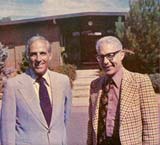Greater Sacramento Strengs: Valley of the Atriums - Page 4
"Eichler had never heard of us," Jim says. "He couldn't believe we were selling these houses in Sacramento." "We took our little handouts," Bill says. "He looked at it. 'That is a good plan!,' Eichler told us, with wonderment in his voice at these country bumpkins." The Strengs suggested building Eichlers in the Valley but said they would need to adapt them for the climate. Eichler seemed hesitant. "He said, 'I want to think about this,' " Jim says.
They never discussed details nor financing. Some time later Eichler called, with a different suggestion. "He didn't want to share plans," Jim says, "he wanted to merge. Bill and I didn't want another partner." It was their last contact with Eichler.

In the 1980s, Jim, who had been on the Sacramento County Planning Commission, was elected to the county Board of Supervisors. He served six-and-a-half years. The firm's activity slowed. The last Streng subdivision was Arlington Farm Apartments in Davis. Sparks, who remained with the Strengs his entire career, moved to Clarksburg, a Delta town near Sacramento, when he retired. He and his second wife lived in a turn-of-the-century farmhouse that Sparks remodeled. Sparks died six years ago of lung cancer. So many people squeezed into his funeral, his daughter says, it started an hour late.
Although the Strengs' sons all pounded nails for the firm when they were in college, none of their children wanted to take on the business. Two of Jim's sons are custom builders—doing traditional-style homes. The Strengs remain fit and active. Jim, 73, loves getting up to the Sierras. Bill, 77, walks a lot—on doctor's orders—often around Streng subdivisions in Davis where he notices second-story additions and other changes that cause shivers.
Covenants designed to protect the architectural integrity of the homes require homeowners to go before a committee before major remodels. But these aren't enforced. The committee includes Bill and Jim. "I haven't been called on a question in at least 10 years," Jim says. "Maybe 20."
Both Strengs remain fans of modern design and are surprised no enterprising developer has taken up the cause. Jim blames that on the inherent conservatism of corporate builders. "I'm impressed because there still is a market. People still do like contemporary design," he says. "It makes me want to go out and build more modern homes again."
Story originally published in 2004
Photos courtesy David Heitz, Jennifer Sparks, and Streng Bros. Homes

Like the Eichlers, Strengs Drawing Keen Interest
Homes built by the Streng Bros. Homes have always been popular in greater Sacramento. But they have never achieved the cult status won by the Eichlers in the San Francisco Bay Area.

More and more people, however, are becoming entranced by the homes' modern style, says David Heitz, a Coldwell Banker realtor who devotes 95 percent of his work to Streng homes and neighborhoods. Heitz lives in a Streng himself, and has worked with several clients who have restored Strengs and furnished them with modern furniture. He publishes a monthly update on the Strengs-for-sale marketplace which he sends out to Streng owners throughout the Sacramento area.

People who seek Streng homes, Heitz says, include professionals, lawyers, and architects—many transplants from the Bay Area. "Everything here in the past was ranch style, but that's not true anymore," he says. "We're behind the Bay Area by several years—but things are changing dramatically." Heitz, himself a Bay Area transplant, says: "I had always wanted to own an Eichler home but I was priced out of the Eichler market."
In Davis, real estate broker Malek Baroody hasn't seen a surge of interest in Streng homes. But he says they have maintained their popularity with people who appreciate spaciousness and light. Many people remodel their Streng homes to provide more space, improve the cabinetry, or redo the windows, he says. Some do it carefully—but many do as they please. Second-story additions are common, he says, and not all of them are appropriate to the style.
But if Heitz is correct in his belief that people are becoming more appreciative of modern design, this may change. "There's starting to be a following now of individuals who realize the true architectural interest of these homes," he says.
- « first
- ‹ previous
- 1
- 2
- 3
- 4




